
copyright © Wartime Heritage Association
Website hosting courtesy of Register.com - a web.com company
Wartime Heritage
ASSOCIATION

Remembering World War II
Norman Joseph Gaudette

Name:
Norman Joseph Gaudette
Rank:
Private
Service Number:
31321913
Service:
398th Anti-Aircraft Artillery AW SP Battalion,
(Automatic Weapons, Self Propelled)
14th Armored Division, US Army
Awards:
Purple Heart
Date of Birth:
July 2, 1910
Place of Birth:
Havelock, Digby Co., NS
Date of Enlistment:
April 21, 1943
Age at Enlistment:
32
Place of Enlistment:
Portland, Maine
Address at Enlistment:
Southport, Lincoln Co., Maine
Marital Status:
Married
Occupation:
Manager
Date of Death:
November 11, 1944
Age:
34
Cemetery:
Epinal American Cemetery, France
Grave:
Section B, Row 18, Grave 11
Norman Joseph Gaudette was the son of Henry Joseph Gaudette (1884 or
85-1961) and Mary Violet (Robicheau) Gaudette (1891-1951). His father
was also both born in Havelock, NS. His mother was born in Weymouth,
Digby Co., NS. He had seven siblings including 4 sisters Lucy Mary (1909-
1976), Rita M (1912-1958), Dorothy Eunice (1923-1989), and Louise Ann
(1927-2003), and 3 brothers Paul Joseph (1918-1986), Edward Thomas
(1919-2012), and Francis Henry (1922-2005).
Norman married Grace Faustina Ellingwood (1916-1965) of Rhode Island
on November 10, 1938, in Southport, Lincoln Co., Maine. They lived in
Southport into the 1940’s. Norman enlisted in the US Army on April 21,
1943, in Portland, Maine.
Just as Norman did, his brother Edward Thomas
(1919-2012) served with the US Army (Service No. 31117507) during the Second World
War. He enlisted July 6, 1942.
His brother Francis Henry Gaudette (January 31, 1922 – December
1, 2005) served with the US Coast Guard in WWII. He enlisted
October 13, 1942, and was discharged March 8, 1946.
Norman was assigned to the 398th Anti-Aircraft Artillery Battalion, a
self-propelled artillery unit. Their purpose was to protect tank
battalions from air attack.
Their armored vehicles included 2 main armored vehicles, the M16 Multiple Gun Motor
Carriage (MGMC), also known as the M16 half-track, equipped with four .50 caliber (12.7
mm) M2 Browning machine guns in an M45 Quadmount, and the M15A1 half-track, officially designated M15
Combination Gun Motor Carriage (CGMC), a self-propelled anti-aircraft gun on a half-track chassis. It was
equipped with one M1 37 mm (1.5 inch) automatic gun and two air-cooled heavy machine guns.
On April 11, 1944, the Battalion was moved to Camp Shanks, New York. After 23 days at Camp Shanks, the
unit was given shipping priority for the upcoming transfer to Europe. Transferred to Camp Edwards, in
western Cape Code in Barnstable Co., Mass., the men were given furlough. Returning from their leave, the
men heard the news of D-Day and the Normandy Landings. They became restless - the feeling was ‘to go
over and get it over with’.
On June 9, 1944, the 398th departed Camp Edwards for Camp Miles
Standish in Taunton, Mass. 11 days later the unit entrained for the Port
of Boston. They departed for the UK on the HMS Aquitania, the 4th
largest liner at the time, on June 22nd with 8000 soldiers aboard.
Seven days later, they docked at Firth on Clyde, Scotland, on June 29,
1944, and proceeded by train to Blackshaw Moor, in Staffordshire,
England. As the American soldiers crossed the English countryside by
train, they poked their heads out of the “tiny little” train cars – to be
met by the English people, from their home windows and streets, with
their hands in the air signalling their Churchill ‘V’ for Victory’s. After
Blackshaw Moor for the night, they moved on to Blanford, a market
town in Dorset, and then on to a marshalling area before reaching
Southampton, England.
Norman’s battalion boarded their landing craft and Liberty ships on July
28th at Southampton, and landed at Utah beach on the afternoon of
July 29, 1944. The 14th Armored Division, to which the 398th would
later be attached, landed on Omaha Beach the next day on July 30,
1944.
From Utah Beach on the Cotentin (or Cherbourg) Peninsula, they proceeded to Sortosville. Their vehicle’s
tracks crawled through the dusty roads of Normandy made narrow from all the rubble. Brick dust was part
of their daily diet as they passed through Carentan, Montebourg, Volognes, Bricquebec, and Periers. They
saw how Normandy had suffered unbelievable destruction, with many of the French people homeless.
On July 25, 1944, the Allies brock through at St. Lo, and the war left Normandy. From Periers Norman’s
Battalion proceeded to Coutances, Granville and Avranches. Upon reaching Avranches the 398th learned
that they were part of Patton’s new Third Army.
Throughout their time in Normandy and into Brittany, the soldiers of the battalion had to contend with
enemy snipers and counterfire from German artillery.
In late September 1944, some of the 389th had the opportunity to see Bing Crosby perform, possibly near
Vézelise, France on September 24th. The 398th was camped in Charmes from September 19 to 26, 1944.
From there it was onward to Luneville, and Thiebaumenil, France. At Luneville the 398th was transferred
from Patton’s 3rd Army to the 7th Army.
On November 11, 1944, the 398th was hit by heavy German artillery fire at Marainville (Marainville-sur-
Madon), in the Department of Vosges, France.
Private Norman Joseph Gaudette was Killed in Action
November 11, 1944, was awarded the Purple Heart,
and was interred at the Epinal American Cemetery in
Section B, Row 18, Grave 11.

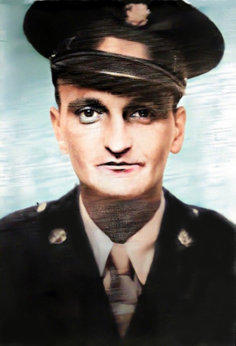
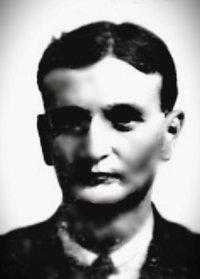
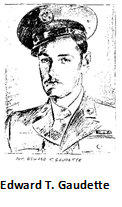
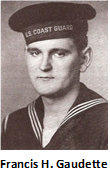
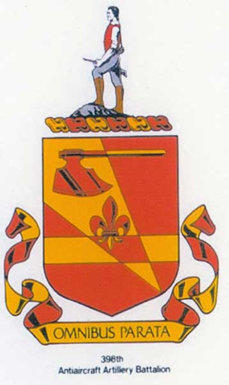



- World War I - Menu
- WWI Stories and Articles
- Photos - Yarmouth Soldiers
- Selection of World War I Songs
- WWI Casualties of Yarmouth, NS
- Those Who Served - Yarmouth, NS
- WWI Casualties Digby Co. NS
- WWI Casualties Shelburne Co. NS
- Merchant Mariners (1915) Yarmouth, NS
- Canadian Forestry Corps - Non Yarmouth Birth/Residence Enlistments
- US Draft Registry - Yarmouth NS Born


- World War II - Menu
- WWII Stories and Articles
- Telegraphist Air Gunners
- WWII Casualties of Nova Scotia
- US Casualties with NS Connection
- Far East/Pacific Casualties with NS Connection
- Merchant Navy Casualties Nova Scotia
- Nova Scotia WWII Casualties Holten Canadian War Cemetery
- D-Day Casualties - Nova Scotia
- CANLOAN Program Casualties - Nova Scotia
- Battle of the Bulge Casualties - Nova Scotia
- WWII Casualties Yarmouth NS
- Yarmouth Casualties - RCAF RAF Canadian Army WWII
- Yarmouth Co., Marriages WWII
- Casualties Non-Born/Residents with Connection to Yarmouth Co., Nova Scotia.
- WWII Casualties Digby Co., NS
- Non-Nova Scotian WWII Casualties Buried in Nova Scotia
- WWII RCAF Casualties Aged 16-18
- Brothers/Sisters Who Served - World War II













